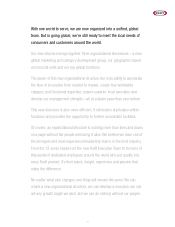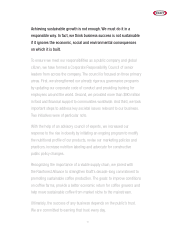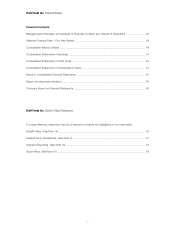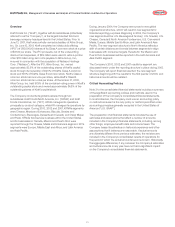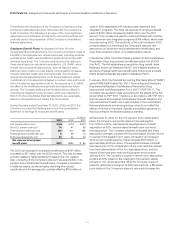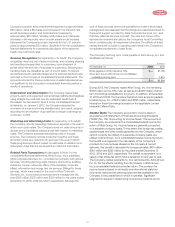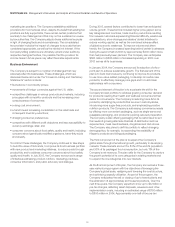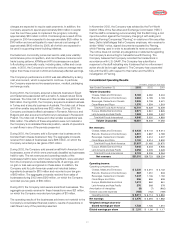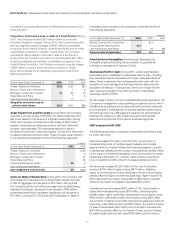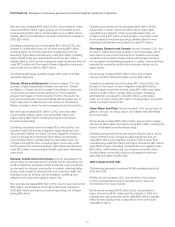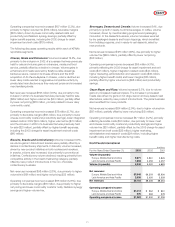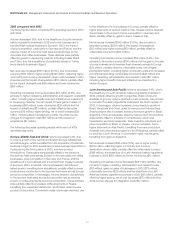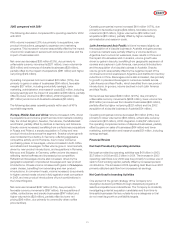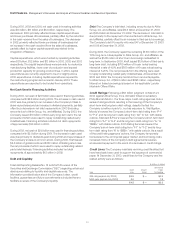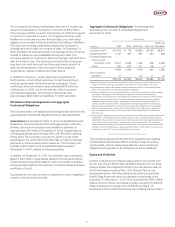Kraft 2003 Annual Report Download - page 27
Download and view the complete annual report
Please find page 27 of the 2003 Kraft annual report below. You can navigate through the pages in the report by either clicking on the pages listed below, or by using the keyword search tool below to find specific information within the annual report.
Company’s pension and postretirement expense by approximately
$65 million, while a fifty-basis-point increase in the discount rate
would decrease pension and postretirement expense by
approximately $55 million. Similarly, a fifty-basis-point decrease
(increase) in the expected return on plan assets would increase
(decrease) the Company’s pension expense for the U.S. pension
plans by approximately $30 million. See Note 14 to the consolidated
financial statements for a sensitivity discussion of the assumed
health care cost trend rates.
Revenue Recognition: As required by U.S. GAAP, the Company
recognizes revenues, net of sales incentives, and including shipping
and handling charges billed to customers, upon shipment of
goods when title and risk of loss pass to customers. Shipping and
handling costs are classified as part of cost of sales. Provisions
and allowances for estimated sales returns and bad debts are also
recorded in the Company’s consolidated financial statements. The
amounts recorded for these provisions and related allowances are
not significant to the Company’s consolidated financial position or
results of operations.
Depreciation and Amortization: The Company depreciates
property, plant and equipment and amortizes definite life intangibles
using straight-line methods over the estimated useful lives of
the assets. As discussed in Note 2 to the consolidated financial
statements, on January 1, 2002, the Company adopted the
provisions of a new accounting standard and, as a result, stopped
recording the amortization of goodwill as a charge to earnings as
of January 1, 2002.
Marketing and Advertising Costs: As required by U.S. GAAP,
the Company records marketing costs as an expense in the year to
which such costs relate. The Company does not defer amounts on
its year-end consolidated balance sheet with respect to marketing
costs. The Company expenses advertising costs in the year
incurred. The Company records consumer incentive and trade
promotion costs as a reduction of revenues in the year in which
these programs are offered, based on estimates of utilization and
redemption rates that are developed from historical information.
Related Party Transactions: As discussed in Note 3 to the
consolidated financial statements, Altria Group, Inc.’s subsidiary,
Altria Corporate Services, Inc., provides the Company with various
services, including planning, legal, treasury, accounting, auditing,
insurance, human resources, office of the secretary, corporate
affairs, information technology and tax services. Billings for these
services, which were based on the cost to Altria Corporate
Services, Inc. to provide such services and a management fee,
were $318 million, $327 million and $339 million for the years ended
December 31, 2003, 2002 and 2001, respectively. Although the
cost of these services cannot be quantified on a stand-alone basis,
management has assessed that the billings are reasonable based on
the level of support provided by Altria Corporate Services, Inc., and
that they reflect all services provided. The cost and nature of the
services are reviewed annually by the Company’s Audit Committee,
which consists solely of independent directors. The effects of these
transactions are included in operating cash flows in the Company’s
consolidated statements of cash flows.
The Company had long-term notes payable to Altria Group, Inc. and
its affiliates as follows:
(in millions)
At December 31, 2003 2002
Notes payable in 2009, interest at 7.0% $— $1,150
Short-term due to Altria Group, Inc. and affiliates
reclassified as long-term 1,410
$— $2,560
During 2003, the Company repaid Altria Group, Inc. the remaining
$1,150 million on the 7.0% note, as well as the $1,410 million of short-
term borrowings reclassified to long-term. In addition, at December
31, 2003 and 2002, the Company had short-term amounts payable
to Altria Group, Inc. of $543 million and $895 million, respectively.
Interest on these borrowings is based on the applicable London
Interbank Offered Rate.
Income Taxes: The Company accounts for income taxes in
accordance with Statement of Financial Accounting Standards
(“SFAS”) No. 109, “Accounting for Income Taxes.” The accounts of
the Company are included in the consolidated federal income tax
return of Altria Group, Inc. Income taxes are generally computed
on a separate company basis. To the extent that foreign tax credits,
capital losses and other credits generated by the Company, which
cannot currently be utilized on a separate company basis, are
utilized in Altria Group, Inc.’s consolidated federal income tax return,
the benefit is recognized in the calculation of the Company’s
provision for income taxes. Based on the Company’s current
estimate, this benefit is calculated to be approximately $100 million,
$240 million and $220 million for the years ended December 31,
2003, 2002 and 2001, respectively. The benefit is dependent on a
variety of tax attributes which have a tendency to vary year to year.
The Company makes payments to, or is reimbursed by, Altria Group,
Inc. for the tax effects resulting from its inclusion in Altria Group,
Inc.’s consolidated federal income tax return. The provision for
income taxes is based on domestic and international statutory
income tax rates and tax planning opportunities available to the
Company in the jurisdictions in which it operates. Significant
judgment is required in determining income tax provisions and in
25




